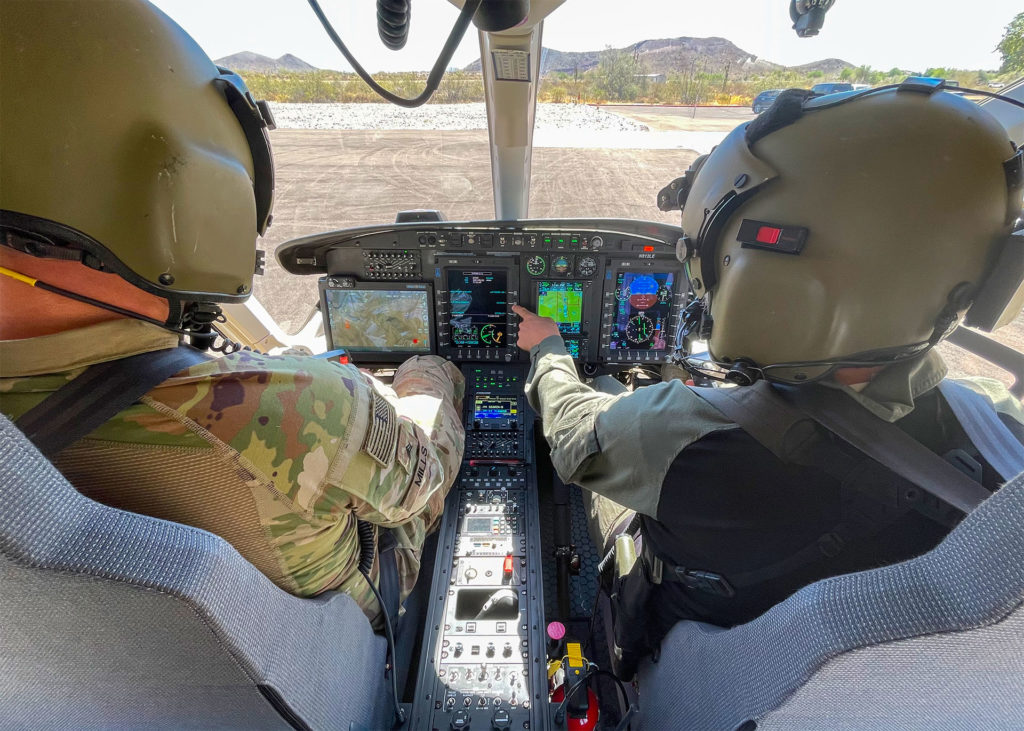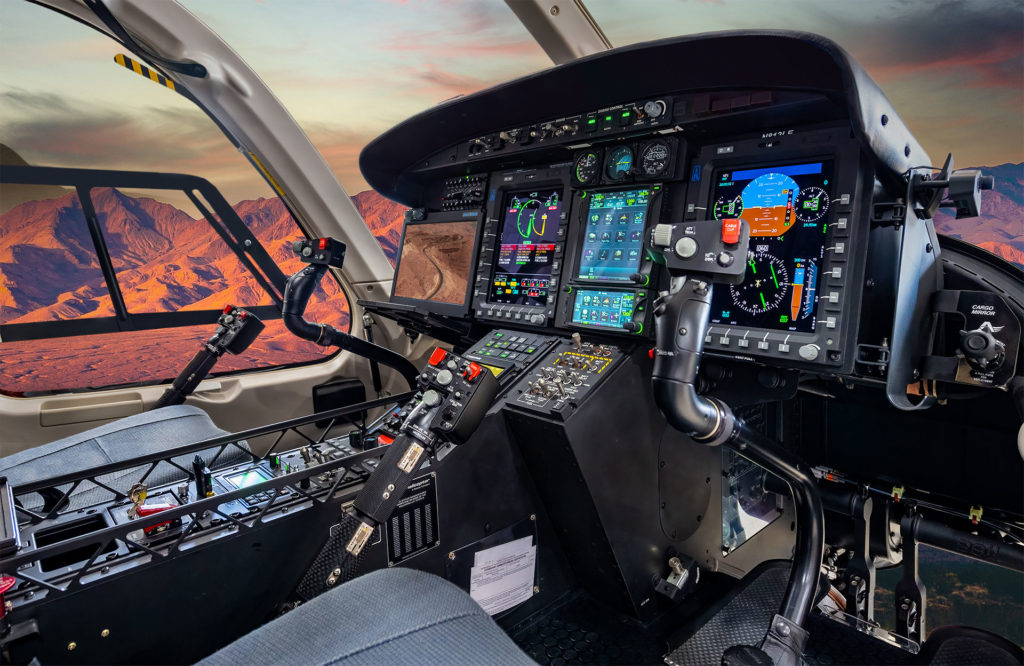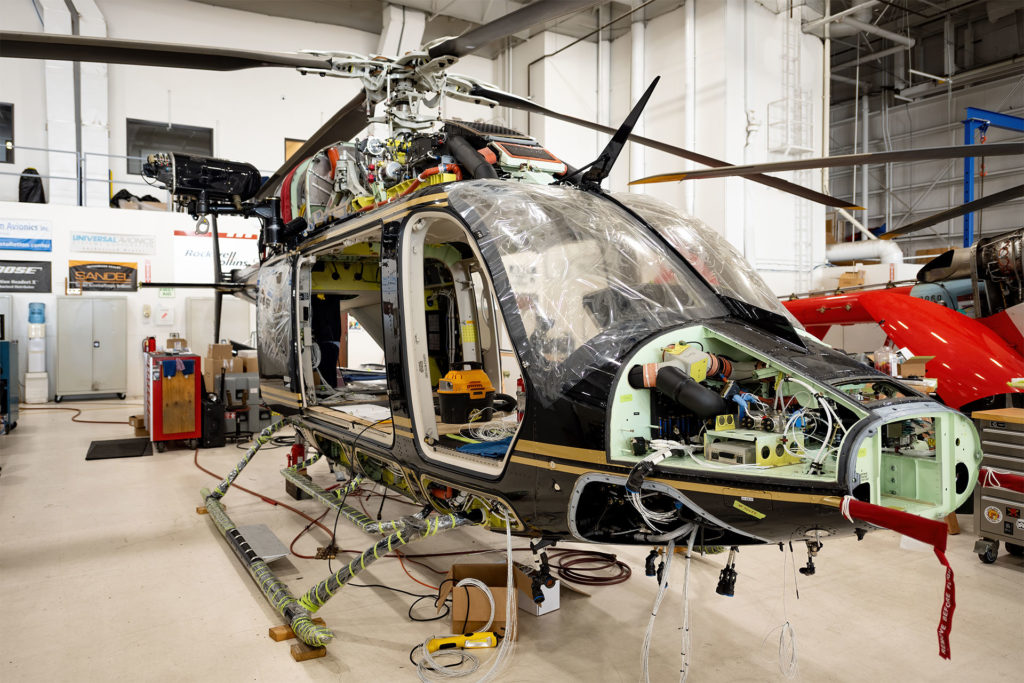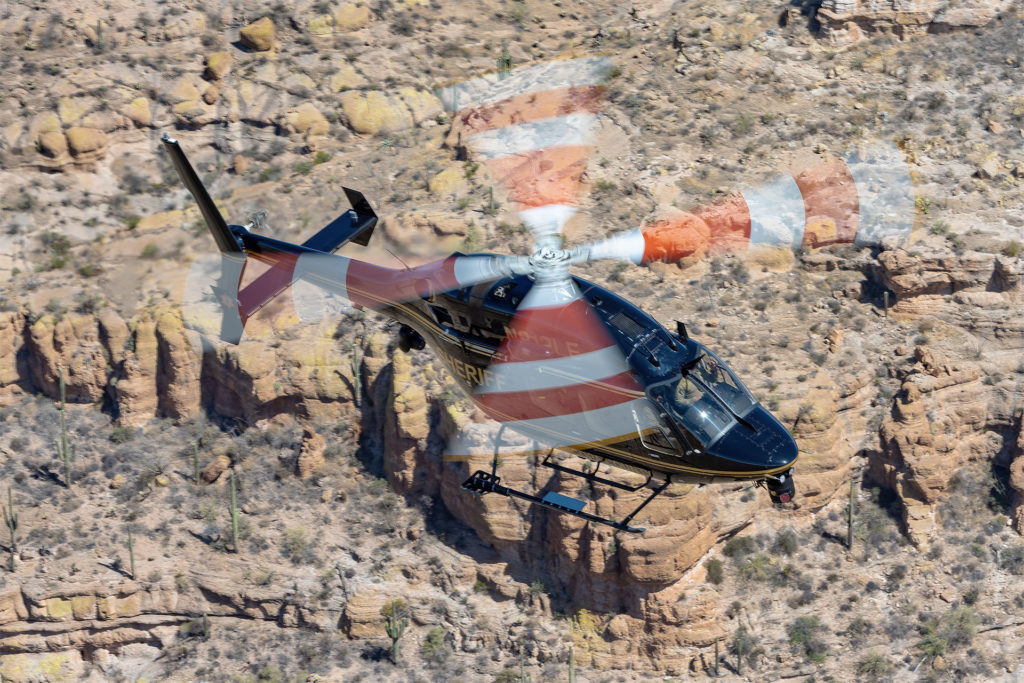On a beautiful Sunday morning in January, a small group of hikers set out for short but strenuous 4.5-mile (seven-kilometer) hike to Pick Axe Canyon, in the rugged Superstition Mountains 40 miles (65 km) east of Phoenix, Arizona.

The hike is considered a “canyoneering route,” requiring proficiency in technical rope skills to navigate some sections including two lengthy rappels.
It was 11:30 a.m. when the Maricopa County Sheriff’s Office (MCSO) received an urgent 911 call. A female in the group had been severely injured after a 90-foot (27-meter) fall during one of those rappels.
MCSO Search-and-Rescue (SAR), Lake Patrol assets, and “Fox 2,” the MCSO Aviation Services Division (ASD) Bell 407GX helicopter, responded to the scene.
The helicopter crew quickly located the victim on a small rocky outcropping in a steep, narrow canyon. They assessed that the rocky terrain would hamper a timely response by ground personnel, but landing the helicopter wasn’t an option either.
Instead, the helicopter hovered alongside a steep hillside and deployed the onboard medic to hike to the victim. The helicopter crew determined their best option to extract their medic and the victim was a “short-haul” or human external cargo (HEC).
“They dropped me off from a hover about 50 yards away from the victim,” said Ed Philpott, a MCSO deputy sheriff assigned to Lake Patrol, the agency’s SAR coordinator and the flight medic on that particular mission. “So, I had to walk across a steep rock face to get to her. She was on a small ledge about four feet wide. There was a vertical wall on one side and a 150- to 200-foot steep angled cliff below. So, I had very little room to work with.”
With Philpott tending to the victim, the helicopter departed to land and configure the aircraft with a “belly band” for short haul. When they returned, they brought additional equipment needed at the scene including a backboard and Bauman Bag. The equipment was delivered to the same location and in the same manner as they deployed Philpott.

After retrieving the equipment, the victim was packaged inside the Bauman Bag and readied for the lift. Philpott and the victim were lifted together, flown a short distance and set down on a hilltop. There, the victim was cross loaded into the rear cabin before being flown down to a waiting air medical provider.
The rugged mountains that surround the greater Phoenix metro area and all throughout Maricopa County provide an excellent setting for outdoor recreation. As a result, MCSO receives a high volume of SAR calls.
“Our SAR and the ASD are normally busiest during the late spring through the early fall when temperatures are high and families are on their summer vacations from school,” ASD Commanding Officer Lt. James Schoeninger told Valor. “With the initial onset of the Covid-19 pandemic in early 2020, MCSO SAR and the ASD saw an immediate, but temporary slowdown in missions and calls for service as the population was unsure of what was unfolding.”
“Our sister state agency, AZDPS, recently conducted an extensive test and review of several models of rotor-wing aircraft for their operations. The clear winner was the Bell 429. “
“Over time, and as more and more businesses closed or cut back operations and people were no longer able or allowed to return to their normal work routine, they began to hit the hiking trails around the county en masse,” Schoeninger said. “Many individuals were poorly prepared and/or unaware of the difficulty many of the trails and hikes would present.”
ASD crews and their SAR partners have long utilized short haul for rescue operations. As a result, all parties are well practiced and highly proficient. But while short haul is indeed a viable method and has been an invaluable tool for the SAR mission, ASD leadership and air crews always understood how a twin-engine, hoist-equipped helicopter would be a game changer, greatly improving safety, performance and efficiency.
A ‘clear winner’
In 2018, the Arizona Department of Public Safety (AZDPS) introduced the region to its new Bell 429. The ASD saw this as an opportunity to showcase the aircraft’s performance and capabilities to MCSO leadership and county government officials.
By early the following year, MCSO had begun the process to acquire its own twin-engine, hoist-equipped helicopter and proposed replacing the oldest of its Bell 407s with a machine similar to the new AZDPS Bell 429.

“Our sister state agency, AZDPS, recently conducted an extensive test and review of several models of rotor-wing aircraft for their operations,” Schoeninger said. “The clear winner was the Bell 429. As we have a nearly identical mission, we were able to piggyback off their testing process and came to the same conclusion.”
To identify the right aircraft for its needs, the MCSO “literally worked the problem backward,” said chief pilot Kevin Kraayenbrink.
“We wanted a dual-purpose ship for patrol and SAR without changing aircraft and crew,” Kraayenbrink said. “We wanted twin-engine, thermal imaging on board, a search light, rescue gear, and a hoist. Basically, we needed a hoist platform that could also go to police calls.
“We plagiarized the heck out of DPS’s program,” Kraayenbrink added. “They asked the same questions we were asking and everyone was coming up with the same answers. They were our testbed and they were very candid with their successes and failures.”

Within months, MCSO submitted a formal request to the county board of supervisors for the purchase of its own 429. The request was ultimately approved and by November 2020 the aircraft was delivered. It was then ferried to McClellan-Palomar Airport in north San Diego County, California, and turned over to Ken Piland and his team at Hangar One Avionics for its avionics/mission equipment completion.
Outfitting the 429
Hangar One is regarded as a premier avionics, maintenance, repair and installation facility supporting all major avionics manufacturers. They have a unique breadth of in-house capabilities for all aspects of avionics completion processes including CNC machining, 3D printing, carbon fiber parts fabrication and laser etching.
“We’ve had a long term relationship with Maricopa County,” said Piland. “I feel like I’ve known those guys forever. Back in the ’90s, when I was with another company, we outfitted two 407s for them. Then with Hangar One we did another 407 several years back. Now they’re into the 429 that gives them the twin engines and the hoist capability. So, we worked with them, helping them in taking what they know and like from the Bell 407 and integrating it into the 429.”

The completion plan for the aircraft was a collaboration between MCSO ASD, Bell, Hangar One and the avionics and equipment vendors: Canyon AeroConnect, (formerly Cobham Aerospace Connectivity), Teledyne FLIR, Collins Aerospace and Trakka Systems. Priority One Air Rescue was also invested as the training provider for the new hoisting program.
The Hangar One team faced a number of engineering challenges during the completion, requiring a bit of creativity to overcome. The installation of the Canyon RT-7000 flexcom tactical radio was a first for the team. It was a complex install requiring six exterior antennas. One of the biggest challenges was finding suitable mounting locations, other than on the belly, so as to ensure clearance for ground handling equipment and off-field landing.
They also needed a solution for mounting the dual horn AEM public address speaker system.
“The only room left to mount it was on the belly,” said Piland. “We utilized the cavity where the nose wheel retracts if you had retractable gear. So we were able to recess it up inside that cavity and keep it low profile and still give them plenty of ground clearance.”
In the rear cabin, Hangar One engineered a unique pedestal-mounted command-and-control workstation built around a 17-inch Macro-Blue monitor. The entire pedestal is easily installed or removed to suit mission needs.
“From this location, the incident commander or other command staff can manage an incident with a bird’s eye view,” said Schoeninger. “They can independently operate the FLIR and HD cameras and recording system, mapping system and spotlight.”
“The aircraft is also equipped with four independent radio systems, two in the front with the pilot and TFO and two in this rear cabin,” Schoeninger added. “Each radio can be operated independently where the pilot can maintain contact and communications with air traffic control and 911 dispatch, and the incident commander can maintain contact with ground units and others without interference.”

A high-definition video camera was integrated into the hoist with a view looking straight down the cable. While it works like other hoist cameras, it does have a somewhat unique feature.
“They configured it so we can not only record what’s happening on the hoist, but it can also be displayed in the cockpit on our tactical display,” said ASD pilot Richie Dickner. “As a pilot, I can glance over and see in real time what’s happening during the hoist evolution. We can confirm what we’re hearing from the hoist operator by looking at the display. Is he out on the skid? Where the load is, how the load is riding, if we have a spin, the status of the tag line… I think it’s as important during a hoist operation as are the gauges.”
Training and maintaining
Prior to the aircraft entering service in mid-March, all pilots attended a two-week course at the Bell training facility in Texas. Once the aircraft was completed and flown back to Phoenix, the crews attended a two-week course with Priority One Air Rescue to begin learning hoisting techniques.
“From what I can tell so far the 429 is awesome for hoisting,” Dickner said. “The power is there and for hoisting the SCAS system really does a great job to stabilize the aircraft and really reduces pilot workload. When we went to initial 429 school they made us fly it [SCAS] turned off and it was pretty squirrely. We were trying to control it like the 407s we were used to flying using larger, deliberate control inputs. But with the SCAS turned on you can just settle down and hold the controls and it becomes really stable.”
Dickner also appreciated another system of the 429: the “go-around button.”
“It’s intended to be used for aborting an approach to the runway but the feature also works if you get disoriented,” Dickner said. “In MCSO’s 429, it’s a single button push, no matter the configuration of your autopilot, and it levels the aircraft, it gives you 75 knot airspeed and a 750-foot-per-minute climb. You also have the ability to adjust the airspeed, like if you’re in a canyon, and it’ll climb until you tell it to stop.”
From a maintenance perspective, the new aircraft has been a fairly easy transition. Director of maintenance Randy Davis-Yates and his two staff mechanics attended two three-week courses at the Bell training academy: one for maintenance and another for avionics and electrical. Back home in Phoenix, a trainer from hoist manufacturer Collins/Goodrich presented an eight-hour course in hoist inspections and maintenance.
In the short time they’ve been operating the 429, Davis-Yates and his staff have so far been pleased.
“We’re occasionally chasing minor electrical gremlins but mechanically it seems to be very sound. Looking at the 429 in comparison to the 407, it seems they actually simplified some of the maintenance to maker it easier,” said Davis-Yates. “Bell did a great job installing the equipment that we had them install. And Hangar One also did an outstanding job, even going above and beyond on the completion and continuing airworthiness documentation. I’ve never seen completion paperwork like that.”
Reflecting on the Pick Axe Canyon short haul, Steve Glennie, who piloted that mission, said it “took over an hour from the time we got on scene to when we landed with the patient. In my estimation the same rescue utilizing the hoist and 429 would’ve been 20 to 30 minutes.”
“The elimination of the rescue tech needing to hike to the victim, landing to configure the short haul gear and another landing to transfer the patient inside the helicopter is crucial time wasted when dealing with the ‘Golden Hour’ of patient care,” Glennie said. “Also, the patient can be placed entirely inside the cabin with door closed for transport. This results in a faster transport due to no airspeed limitations having the doors open.”
“The safety and redundancy of a multi-engine helicopter goes without saying. When a crew is at a hover out of ground effect in a box canyon, a multi-engine helicopter is much safer and is becoming the industry standard,” Glennie added.
Future fleet
Looking to the future, the ASD hopes the successes of this new aircraft may lead to acquiring a second hoist-equipped 429 to maintain consistent 24/7 air support readiness and coverage. Two like machines will improve the odds of one aircraft being in-service if the other is undergoing maintenance. “The best spare hoist is on a spare helicopter,” Kraayenbrink said.
ASD uses the aircraft’s registration numbers to memorialize deputies killed in the line of duty.

“Our 2014 Bell 407 has the tail number N977MS dedicated to Deputy William ‘Bill’ Coleman, serial #977, who was killed in the line of duty on Jan. 8, 2012,” Schoeninger explained. “This new Bell 429 has the tail number N812LE and is dedicated to Deputy Kenneth ‘Ken’ Blair, serial #812, who was killed in the line of duty on Sept. 28, 1995.”
“The Arizona desert is as unforgiving as anywhere on the planet,” said Schoeninger. “As we continue past the year mark of the pandemic combined with the slow process of reopening the country, the ASD is as busy as ever. In the past, it was somewhat rare to have multiple rescue missions in a single day. Now, that is becoming routine.”





